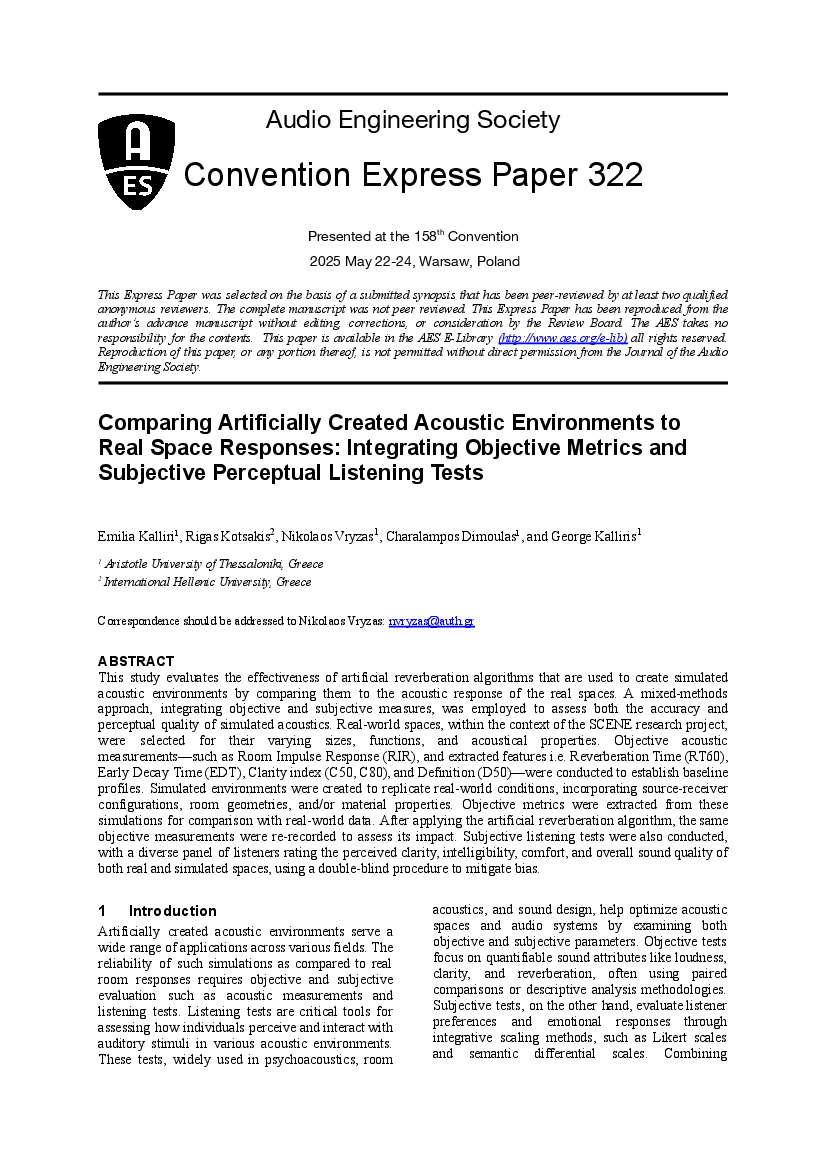Home / Publications / E-library page
You are currently logged in as an
Institutional Subscriber.
If you would like to logout,
please click on the button below.
Home / Publications / E-library page
Only AES members and Institutional Journal Subscribers can download
This study evaluates the effectiveness of artificial reverberation algorithms that are used to create simulated acoustic environments by comparing them to the acoustic response of the real spaces. A mixed-methods approach, integrating objective and subjective measures, was employed to assess both the accuracy and perceptual quality of simulated acoustics. Real-world spaces, within a research project, were selected for their varying sizes, functions, and acoustical properties. Objective acoustic measurementssuch as Room Impulse Response (RIR), and extracted features i.e. Reverberation Time (RT60), Early Decay Time (EDT), Clarity index (C50, C80), and Definition (D50)were conducted to establish baseline profiles. Simulated environments were created to replicate real-world conditions, incorporating source-receiver configurations, room geometries, and/or material properties. Objective metrics were extracted from these simulations for comparison with real-world data. After applying the artificial reverberation algorithm, the same objective measurements were re-recorded to assess its impact. Subjective listening tests were also conducted, with a diverse panel of listeners rating the perceived clarity, intelligibility, comfort, and overall sound quality of both real and simulated spaces, using a double-blind procedure to mitigate bias. Statistical analyses, including paired t-tests and correlation analysis, were performed to assess the relationship between objective and subjective evaluations. This approach provides a comprehensive framework for evaluating the algorithms ability to enhance simulated acoustics and align them with real-world environments.
Author (s): Kalliri, Emilia; Kotsakis, Rigas; Vryzas, Nikolaos; Dimoulas, Charalampos; Kalliris, George
Affiliation:
Aristotle University of Thessaloniki
(See document for exact affiliation information.)
AES Convention: 158
Paper Number:322
Publication Date:
2025-05-12
Import into BibTeX
Permalink: https://aes2.org/publications/elibrary-page/?id=22873
(391KB)
Click to purchase paper as a non-member or login as an AES member. If your company or school subscribes to the E-Library then switch to the institutional version. If you are not an AES member Join the AES. If you need to check your member status, login to the Member Portal.

Kalliri, Emilia; Kotsakis, Rigas; Vryzas, Nikolaos; Dimoulas, Charalampos; Kalliris, George; 2025; Comparing Artificially Created Acoustic Environments to Real Space Responses: Integrating Objective Metrics and Subjective Perceptual Listening Tests [PDF]; Aristotle University of Thessaloniki; Paper 322; Available from: https://aes2.org/publications/elibrary-page/?id=22873
Kalliri, Emilia; Kotsakis, Rigas; Vryzas, Nikolaos; Dimoulas, Charalampos; Kalliris, George; Comparing Artificially Created Acoustic Environments to Real Space Responses: Integrating Objective Metrics and Subjective Perceptual Listening Tests [PDF]; Aristotle University of Thessaloniki; Paper 322; 2025 Available: https://aes2.org/publications/elibrary-page/?id=22873
@article{kalliri2025comparing,
author={kalliri emilia and kotsakis rigas and vryzas nikolaos and dimoulas charalampos and kalliris george},
journal={journal of the audio engineering society},
title={comparing artificially created acoustic environments to real space responses: integrating objective metrics and subjective perceptual listening tests},
year={2025},
number={322},
month={may},}
TY – paper
TI – Comparing Artificially Created Acoustic Environments to Real Space Responses: Integrating Objective Metrics and Subjective Perceptual Listening Tests
AU – Kalliri, Emilia
AU – Kotsakis, Rigas
AU – Vryzas, Nikolaos
AU – Dimoulas, Charalampos
AU – Kalliris, George
PY – 2025
JO – Journal of the Audio Engineering Society
VL – 322
Y1 – May 2025